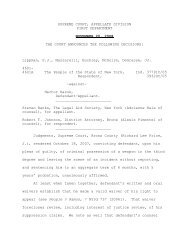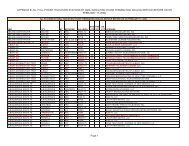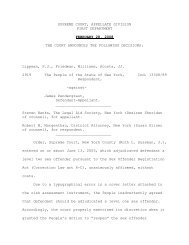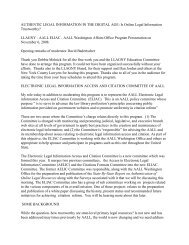april 15, 2008 - Criminal Law Library Blog
april 15, 2008 - Criminal Law Library Blog
april 15, 2008 - Criminal Law Library Blog
Create successful ePaper yourself
Turn your PDF publications into a flip-book with our unique Google optimized e-Paper software.
excessive. We held the appeal in abeyance and remanded the<br />
matter for a hearing on his motion to suppress physical evidence<br />
(42 AD3d 160). After the hearing on July 26, 2007, the court<br />
denied the motion. The parties have submitted supplemental<br />
briefs concerning the propriety of that determination.<br />
The hearing court credited the police officer’s testimony,<br />
noting that the arresting officers were experienced police who<br />
had made numerous narcotics arrests. The court also noted that<br />
defendant’s vehicle had been used as a “drug courier car”<br />
approximately one prior to this incident. Based on the totality<br />
of the circumstances, including the observations of the exchange<br />
between defendant and the woman in defendant’s vehicle, the court<br />
determined there was probable cause for defendant’s arrest and<br />
denied his motion to suppress the physical evidence seized by the<br />
police. We agree.<br />
To sustain a finding of probable cause to arrest, the<br />
evidence must show that the police possessed of information that<br />
would lead a reasonable person to conclude it was more probable<br />
than not that a crime had been committed, and, that the person<br />
being arrested defendant was the perpetrator (People v Radoncic,<br />
239 AD2d 176, 179 [1997], lv denied 90 NY2d 897 [1997]).<br />
Although the arresting officers here were assigned at that time<br />
to the anti-crime unit, two of them were highly experienced<br />
narcotics officers, with between 250-300 and 300-400 narcotics<br />
46
















